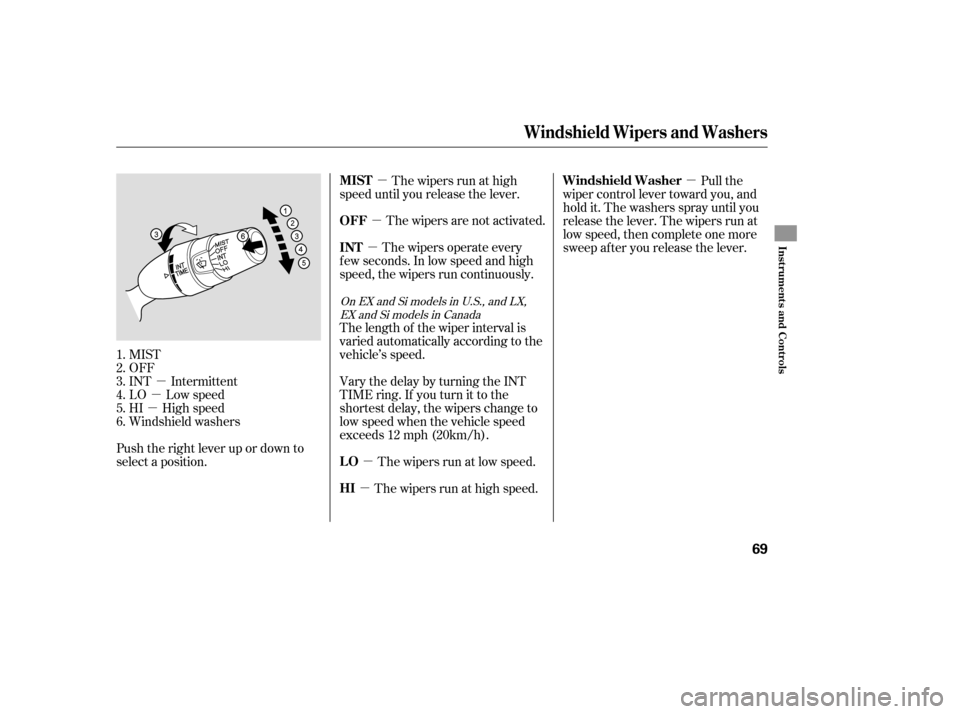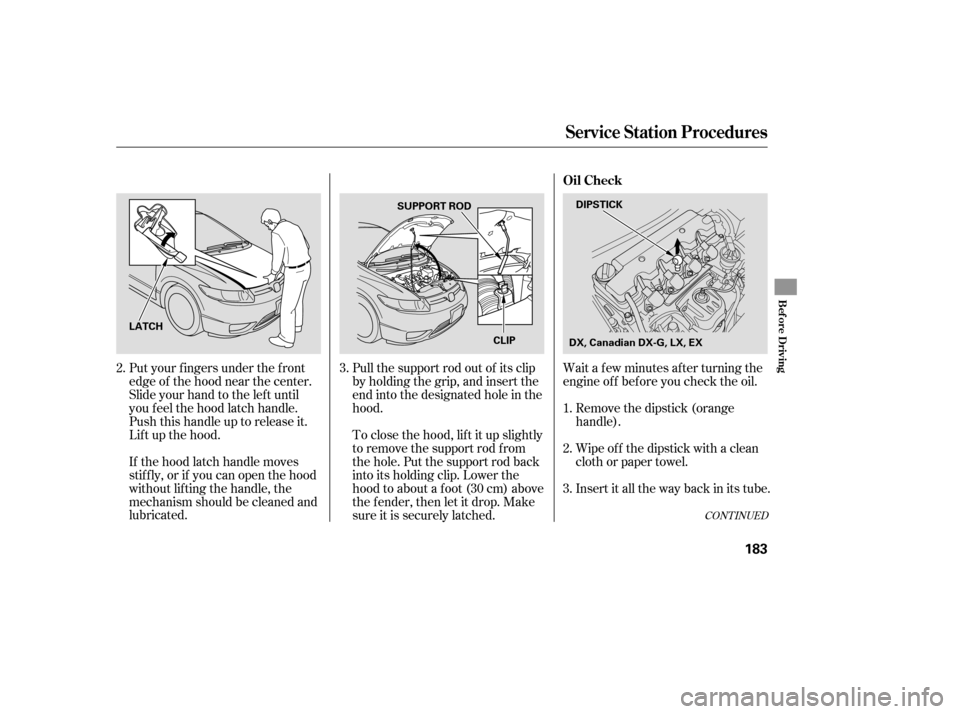Page 73 of 307

�µ
�µ
�µ �µ
�µ
�µ
�µ �µ �µ
Push the right lever up or down to
select a position. MIST
OFF
INT Intermittent
LO Low speed
HI High speed
Windshield washers The wipers run at high
speed until you release the lever.
The wipers are not activated.
The wipers operate every
f ew seconds. In low speed and high
speed, the wipers run continuously.
The wipers run at high speed.The wipers run at low speed.
The length of the wiper interval is
varied automatically according to the
vehicle’s speed.
Vary the delay by turning the INT
TIME ring. If you turn it to the
shortest delay, the wipers change to
low speed when the vehicle speed
exceeds 12 mph (20km/h). Pull the
wiper control lever toward you, and
hold it. The washers spray until you
release the lever. The wipers run at
low speed, then complete one more
sweep after you release the lever.
1.
2.
3.
4.
5.
6.
OnEXandSimodelsinU.S.,andLX, EXandSimodelsinCanada
Windshield Wipers and Washers
MIST
OFF
INT
HI LO Windshield Washer
Inst rument s and Cont rols
69
�����—�����—�����y�
�������������y���
�(�+���������y���������y
Page 77 of 307
Push the lever under the steering
column all the way down.Push the lever up to lock the
steering wheel in position.
Move the steering wheel so it
points toward your chest, not
toward your f ace. Make sure you
can see the instrument panel
gauges and indicators. Make sure you have securely
locked the steering wheel in place
by trying to move it up, down, in,
and out.
Make any steering wheel
adjustments before you start driving.
1.4. 3.
2.
Steering Wheel A djustments
Inst rument s and Cont rols
73
Adjusting the steering wheel
position while driving may
cause you to lose control of the
vehicle and be seriously injured
inacrash.
Adjust the steering wheel only
when the vehicle is stopped.
�����—�����—�����y�
������
����
�y���
�(�+���������y���������y
Page 187 of 307

Wait a f ew minutes af ter turning the
engine of f bef ore you check the oil.
Put your f ingers under the f ront
edge of the hood near the center.
Slide your hand to the lef t until
you f eel the hood latch handle.
Push this handle up to release it.
Lif t up the hood.
If the hood latch handle moves
stif f ly, or if you can open the hood
without lifting the handle, the
mechanism should be cleaned and
lubricated. Pull the support rod out of its clip
by holding the grip, and insert the
end into the designated hole in the
hood.
To close the hood, lif t it up slightly
to remove the support rod f rom
the hole. Put the support rod back
into its holding clip. Lower the
hood to about a f oot (30 cm) above
the fender, then let it drop. Make
sure it is securely latched.
Remove the dipstick (orange
handle).
Insert it all the way back in its tube. Wipe of f the dipstick with a clean
cloth or paper towel.
3. 1.
2.
3.
2.
CONT INUED
Service Station Procedures
Oil Check
Bef ore Driving
183
DIPSTICK
SUPPORT ROD
CLIP
LATCH
DX, Canadian DX-G, LX, EX
�����—�����—�����y�
������
��
���y���
�(�+���������y���
�����y
Page 195 of 307
This section gives you tips on
starting the engine under various
conditions, and how to operate the
manual and automatic transmissions.
It also includes important
information on parking your vehicle,
and the braking system........................
Driving Guidelines .192
........................
Preparing to Drive .193
.......................
Starting the Engine .194
...................
Manual Transmission .195
..............
Automatic Transmission .198
...........................................
Parking .202
.............................
Braking System .203
...............
Anti-lock Brakes (ABS) .204
...........................
Towing a Trailer .205
Driving
Driving
191
�����—�����—�����y�
�������������y���
�(�+���������y���
�����y
Page 206 of 307

If your vehicle has an automatic
transmission, set the parking brake
bef ore you put the transmission in
Park. This keeps the vehicle f rom
moving and putting pressure on the
parking mechanism in the
transmission.If the vehicle is f acing uphill, turn
the front wheels away from the
curb. If you have a manual
transmission, put it in f irst gear.
If the vehicle is f acing downhill,
turn the front wheels toward the
curb. If you have a manual
transmission, put it in reverse gear.
Make sure the parking brake is
f ully released bef ore driving away.
Driving with the parking brake
partially set can overheat or
damage the rear brakes.
Make sure the moonroof (if
equipped) and the windows are
closed.
Lock the doors. Place any packages, valuables, etc.,
in the trunk or take them with you. Turn of f the lights.
Always use the parking brake when
you park your vehicle. Make sure
the parking brake is set f irmly, or
your vehicle may roll if it is parked
on an incline.
Check the indicator on the
instrument panel to verif y that the
security system is set.
Never park over dry leaves, tall
grass, or other f lammable
materials. The hot three way
catalytic converter could cause
these materials to catch on fire.
On vehicles with security system
Parking T ips
Parking
202
Never install a sunshade between the
upper and lower meters on the
instrument panel. If you do, you could
cause heat damage to the upper meter
on a very hot day.
�����—�����—�����y�
�������������y���
�(�+���������y���������y
Page 209 of 307

It only helps with the
steering control during braking.
such as trying to take a
corner too f ast or making a sudden
lane change. Always drive at a safe
speed f or the road and weather
conditions.
Always steer moderately
when you are braking hard. Severe
or sharp steering wheel movement
can still cause your vehicle to veer
into oncoming traffic or off the road. on loose or
uneven surf aces, such as gravel or
snow, than a vehicle without anti-
lock. Slow down, and allow a greater
distance between vehicles under
those conditions. Your vehicle is not designed to tow a
trailer; Attempting to do so can void
your warranties.
A BS does not reduce the time or
distance it takes to stop the
vehicle.
A BS will not prevent a skid that
results f rom changing direction
abruptly,
A BS cannot prevent a loss of
stability. A vehicle with A BS may require a
longer distance to stop
Important Saf ety Reminders
Towing a Trailer
Anti-Lock Brakes (ABS), Towing a Trailer
Driving
205
�����—�����—�����y�
�������������y���
�(�+���������y���������y
Page 252 of 307
Check the condition of the battery
monthlybylookingatthetest
indicator window. The label on the
battery explains the test indicator’s
colors.If additional battery maintenance is
needed, see your dealer or a
qualif ied technician.
Battery posts,
terminals, and related accessories
contain lead and lead compounds.
Check the terminals f or corrosion (a
white or yellowish powder). To
remove it, cover the terminals with a
solution of baking soda and water. It
will bubble up and turn brown. When
this stops, wash it of f with plain
water. Dry off the battery with a
cloth or paper towel. Coat the
terminals with grease to help prevent
f urther corrosion.
Checking the Battery
WARNING:
Wash your hands af ter handling.
248
Si
TEST INDICATOR WINDOW
TEST INDICATOR WINDOW
DX, Canadian DX-G, LX, EX
�����—�����—�����y�
����
��������y���
�(�+���������y�������
�y
Page 254 of 307

If you need to park your vehicle f or
an extended period (more than 1
month), there are several things you
should do to prepare it f or storage.
Proper preparation helps prevent
deterioration and makes it easier to
get your vehicle back on the road. If
possible, store your vehicle indoors.Fill the f uel tank.
Change the engine oil and f ilter. Block the rear wheels.
If the vehicle is to be stored f or a
longer period, it should be
supported on jackstands so the
tires are of f the ground.
Wash and dry the exterior
completely.
Cleantheinterior.Makesurethe
carpeting, floor mats, etc., are
completely dry. Cover the vehicle with a
‘‘breathable’’ cover, one made
f rom a porous material such as
cotton. Non-porous materials, such
as plastic sheeting, trap moisture,
which can damage the paint.
Leave one window open slightly (if
the vehicle is being stored
indoors). If possible, periodically run the
engine until it reaches f ull
operating temperature (the
cooling f ans cycle on and of f
twice). Pref erably, do this once a
month.
To minimize sticking, apply a
silicone spray lubricant to all door
and trunk seals. Also, apply a
vehiclebodywaxtothepainted
surfaces that mate with the door
and trunk seals. Support the f ront wiper blade
arms with a f olded towel or rag so
they do not touch the windshield. Disconnect the battery.
Leave the parking brake off. Put
the transmission in reverse
(manual) or Park (automatic).
Vehicle Storage
250
�����—�����—�����y�
����
��������y���
�(�+���������y���������y